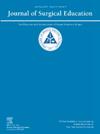Learning Barriers and Facilitators for Medical Students in General Surgical Rotations: Insights for Students and Teachers
IF 2.1
3区 医学
Q1 EDUCATION, SCIENTIFIC DISCIPLINES
引用次数: 0
Abstract
Objective
This study explored learning barriers and facilitators medical students encountered during a general surgical rotation in various surgical environments, to create a framework to enhance learning in these environments.
Design
This was a cross-sectional qualitative study using an open-ended questionnaire with separate versions for students and teachers. An inductive thematic analysis was conducted, followed by a theory-informed deductive analysis.
Setting
The study was conducted at Christchurch Hospital, a tertiary care teaching hospital in New Zealand, during general surgical rotations.
Participants
Participants included 38 fourth year medical students and 31 surgical teachers from a single institution. All participants were recruited on a voluntary basis, and responses were anonymized.
Results
Both students and teachers identified active patient care involvement as a key facilitator of learning. Proactive students were noted to receive more opportunities for engagement, creating a positive feedback loop that improved motivation and learning outcomes. Teachers emphasized attendance and engagement as crucial, while students highlighted the importance of clear communication regarding roles and expectations. A lack of active patient care involvement was a commonly cited barrier, with students attributing this to overcrowded settings and unclear expectations, while teachers viewed it as a result of student passivity. Overcrowding during ward rounds and in operating theatres hindered active involvement but allowed for limited passive learning. These findings aligned with a theoretical model of workplace learning for junior doctors.
Conclusions
The study highlights the importance of active patient care involvement, clear communication and proactive student behaviors to facilitate learning in surgical rotations. Strategies such as smaller group ward rounds, role clarification, and pre-rotation instructional materials may mitigate barriers. These findings can guide the development of interventions to improve student learning in surgical settings.
普通外科轮转医学生的学习障碍和促进因素:对学生和教师的见解
目的探讨医学生在不同的外科环境中在普通外科轮转中遇到的学习障碍和促进因素,以建立一个框架来促进这些环境中的学习。设计:这是一项横断面定性研究,采用开放式问卷,对学生和教师分别进行问卷调查。首先进行归纳性主题分析,然后进行理论推导分析。该研究是在新西兰的三级护理教学医院克赖斯特彻奇医院进行的,在普通外科轮转期间进行。参与者包括来自同一机构的38名四年级医学生和31名外科教师。所有参与者都是在自愿的基础上招募的,并且回答是匿名的。结果学生和教师都认为积极的病人护理参与是学习的关键促进因素。积极主动的学生获得了更多的参与机会,创造了一个积极的反馈循环,提高了动机和学习成果。老师们强调出勤和参与是至关重要的,而学生们则强调关于角色和期望的清晰沟通的重要性。缺乏积极的病人护理参与是一个常见的障碍,学生将其归因于过度拥挤的环境和不明确的期望,而教师则认为这是学生被动的结果。查房和手术室的过度拥挤阻碍了积极参与,但允许有限的被动学习。这些发现与初级医生工作场所学习的理论模型相一致。结论:本研究强调了积极的患者护理参与、清晰的沟通和积极的学生行为对促进外科轮转学习的重要性。诸如小组查房、角色澄清和轮转前指导材料等策略可以减轻障碍。这些发现可以指导干预措施的发展,以提高学生在外科环境中的学习。
本文章由计算机程序翻译,如有差异,请以英文原文为准。
求助全文
约1分钟内获得全文
求助全文
来源期刊

Journal of Surgical Education
EDUCATION, SCIENTIFIC DISCIPLINES-SURGERY
CiteScore
5.60
自引率
10.30%
发文量
261
审稿时长
48 days
期刊介绍:
The Journal of Surgical Education (JSE) is dedicated to advancing the field of surgical education through original research. The journal publishes research articles in all surgical disciplines on topics relative to the education of surgical students, residents, and fellows, as well as practicing surgeons. Our readers look to JSE for timely, innovative research findings from the international surgical education community. As the official journal of the Association of Program Directors in Surgery (APDS), JSE publishes the proceedings of the annual APDS meeting held during Surgery Education Week.
 求助内容:
求助内容: 应助结果提醒方式:
应助结果提醒方式:


